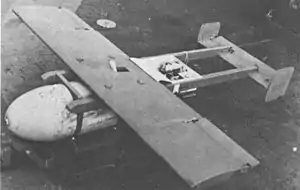GB-1
The GB-1, also known as the "Grapefruit bomb" and as XM-108,[1] was a glide bomb produced by Aeronca Aircraft for the United States Army Air Forces during World War II. Intended to allow bombers to release bombs from outside the range of enemy defenses, over one thousand GB-1s were used in combat before the end of the war.
| GB-1 | |
|---|---|
 | |
| Type | Glide bomb |
| Place of origin | United States |
| Service history | |
| In service | 1943–1945 |
| Used by | United States Army Air Forces |
| Production history | |
| Designed | 1941–1943 |
| Manufacturer | Aeronca Aircraft |
| Specifications | |
| Wingspan | 12 feet (3.7 m) |
| Warhead | 2,000 lb (910 kg) M34 GP bomb |
Operational range | 20 miles (32 km) |
| Maximum speed | 230 miles per hour (370 km/h) |
Guidance system | Preset azimuth |
Launch platform | B-17 Flying Fortress |
Design and development
The U.S. Army Air Corps – which would later become the U.S. Army Air Forces – initiated development of a glide bomb design in March 1941.[2] Intended to allow bombers to stand off outside the range of enemy flak while releasing their bombload, while also potentially allowing for more precise targeting due to the shallow glide path the bomb would follow, the design resulted in three prototypes; one developed by Aeronca designated GB-1; a design by Bellanca designated GB-2, and the Timm Aircraft-designed GB-3.[3]
The GB-1 mated a 12-foot (3.7 m) wing and twin-tail empennage of conventional small-aircraft design to a standard M34 2,000-pound (910 kg) bomb.[2] A gyrostabilizer-based autopilot controlling azimuth was used,[2] allowing the bomb to be set to a specific course following release at a specific altitude and target distance;[1] gliding at a speed of 230 miles per hour (370 km/h), range from a release height of 15,000 feet (4,600 m) was 20 miles (32 km).[3]
Operational history
Selected for production over the competing GB-2 and GB-3 due to its simpler control system and its proving more practical for bomber carriage, production of the GB-1 began in May 1943;[2] arriving in the combat zone in September, operational use was delayed due to the limited bombload the glider imposed – a B-17 Flying Fortress bomber could carry only two GB-1s on a mission, one on a rack under each of the bomber's wings – and the accuracy of the GB-1 proving to be significantly worse than that of ordinary bombs. Despite this, by May 1944 the first releases of GB-1s were undertaken.[3] On 28 May 1944, 42 of 113 glide bombs released hit Cologne, after being released 18 miles from the Eifeltor marshaling yard in the city at 195 miles per hour (314 km/h); many failed to hold an electrical charge in their batteries, causing their autopilots to fail.[4] German gunners mistook the bombs for aircraft they were shooting down, claiming over 90 kills.[1] Due to the inaccuracy the bombs demonstrated, the Eighth Air Force did not use the glide bombs again;[1] however other units would go on to use over a thousand GB-1s before the end of the war.[3]
During the war, variants of the GB-1 using a contrast seeker for anti-shipping use (GB-5,[5] GB-12),[6] heat seeking (GB-6),[5] semi-active radar homing (GB-7),[5] radio command guidance (GB-8),[5] television guidance (GB-10),[3] a flare seeker (GB-13),[6] and active radar homing (GB-14)[6] were developed, however none progressed beyond the testing stage.[3] A version for use in dispersing chemical agents, the GB-11, was also trialled but cancelled due to the end of the war;[6] the GT-1 torpedo-delivering glider was also derived from the GB-1.[7]
Production of the GB-1 was terminated in January 1945;[2] following the end of the war, the bomb was taken out of service.[3]
References
Citations
- 379th 2000 p.39.
- Ordway and Wakeford 1960, p.119.
- Parsch 2003
- Johnson 1995, pp. 105–108
- Ordway and Wakeford 1960, p.120.
- Ordway and Wakeford 1960, p.121.
- Ordway and Wakeford 1960, p.122.
Bibliography
- 379th Bombardment Group (H) WWII Association (2000). 379th Bombardment Group (H) Anthology, Volume One: November 1942-July 1945. Paducah, KY: Turner Publishing. ISBN 978-1-56311-578-3.
- Johnson, Richard Riley (1995). Twenty Five Milk Runs (and a few others): To Hell's Angels and back. Victoria, BC: Trafford. ISBN 1-4120-2501-X.
- Ordway, Frederick Ira; Ronald C. Wakeford (1960). International Missile and Spacecraft Guide. New York: McGraw-Hill. ASIN B000MAEGVC.
- Parsch, Andreas (16 February 2003). "GB Series". Directory of U.S. Military Rockets and Missiles, Appendix 1: Early Missiles and Drones. Designation-Systems. Retrieved 2017-12-14.
External links
 Media related to GB-1 at Wikimedia Commons
Media related to GB-1 at Wikimedia Commons